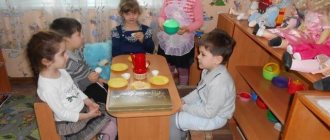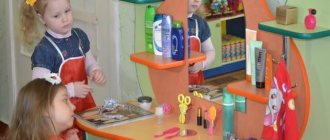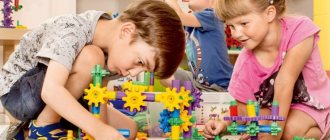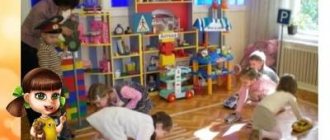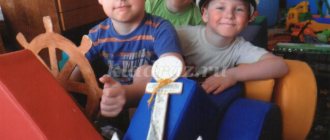Role-playing games in preschool educational institutions. The role of play in a child's life.
We are having fun
Goal:
to attract children to participate in humorous fun, to develop independence skills in organizing and preparing fun, to promote the unification of children, to develop the emotional sphere of the child, to cultivate optimism, love of life, a sense of teamwork, and mutual assistance.
Equipment:
everything necessary that a child can use to improvise pranks and attractions.
Age:
5–6 years.
Progress of the game:
The teacher invites the children to organize a competition. You can come up with and show a funny story, a fable, show a trick, etc. A jury is selected to evaluate the result. After each performance they give their ratings. At the end of the game, the points are tallied and the winner is announced. He is awarded the “Veselchak” medal.
In the cafe
Target:
teach a culture of behavior in public places, be able to perform the duties of a cook and waiter.
Equipment:
necessary equipment for the cafe, toys-dolls, money.
Age:
5–6 years.
Progress of the game:
Buratino comes to visit the children. He met all the children and made friends with other toys. Pinocchio decides to invite his new friends to a cafe to treat them to ice cream. Everyone goes to the cafe. There they are served by waiters. Children learn to place an order correctly and thank you for the service.
Trip around the world
Target:
expand children's horizons, consolidate knowledge about parts of the world, different countries, cultivate a desire to travel, friendships, expand children's vocabulary: “captain”, “travel around the world”, “Asia”, “India”, “Europe”, “Pacific Ocean” "
Equipment:
ship made of building material, steering wheel, binoculars, world map.
Age:
6–7 years old.
Progress of the game:
The teacher invites the children to go on a trip around the world by ship. If desired, children are chosen for the roles of Captain, Radio Operator, Sailor, Midshipman. We consolidate knowledge about what these people do on the ship - their rights and responsibilities. The ship sails through Africa, India, and other countries and continents. Sailors have to deftly steer the ship so as not to collide with an iceberg and cope with the storm. Only well-coordinated work and friendship help them cope with this test.
On city roads
Target:
consolidate children's knowledge about the rules of the road, introduce them to a new role - a traffic controller, cultivate self-control, patience, and attention on the road.
Equipment:
toy cars, flags for traffic controllers - red and green.
Age:
5–7 years.
Progress of the game:
children are offered to build a beautiful building - a theater. We choose a place to build. But first you need to transport the building material to the right place. Car drivers can easily cope with this. Children take cars and go to get building materials. But here’s the bad news: the traffic lights don’t work on the main roads. To avoid an accident on the road, it is necessary for the traffic of cars to be controlled by a traffic controller. Select a Regulator. He forms a circle. He holds red and green flags in his hands. A red flag means “stop”, a green flag means “go”. Everything will be alright now. The traffic controller controls the traffic.
MAGAZINE Preschooler.RF
The importance of role-playing games in the life of a preschoolerN.V. Mikhachik, teacher at MBDOU “Child Development Center – Kindergarten No. 9 “Rodnichok”, Nyandoma
“A game is in no way an exercise in some particular function. This is the form of life of a preschooler, the main means of his development and the formation of specific human abilities...” D.B. Elkonin
In the context of the implementation of the Federal State Educational Standard and the requirements for the basic general education program of preschool education, a significant difference is the exclusion of educational activities from the educational process as not corresponding to the patterns of child development at the stage of preschool childhood. It becomes urgent for preschool teachers to search for other forms and methods of working with children.
At each age, there is a leading activity, within which new types of activity arise, mental processes develop, and mental new formations arise.
Play is undoubtedly the leading activity of a preschooler. It is through play that a child learns about the world and prepares for adult life. When properly organized, the game creates conditions for the development of the child’s physical, intellectual and personal qualities, the formation of prerequisites for educational activities and ensuring the social success of the preschooler. Three interconnected lines of child development: feel-know-create harmoniously fit into the child’s natural environment - a game, which for him is both entertainment and a way of understanding the world of people, objects, nature, as well as the sphere of application of his imagination. The game acts as a kind of bridge from the world of children to the world of adults, where everything is intertwined and interconnected.
A number of conditions contribute to the successful implementation of gaming activities and increasing the effectiveness of play development in preschoolers:
- Free and voluntary inclusion of children in the game: not imposition of games, but involvement in it.
- Children must understand well the meaning and content of the game, its rules, and the idea of each game role.
- The game should have a positive impact on the development of the emotional-volitional, intellectual and rational-physical spheres of its participants. With the help of the organization of gaming technologies, children are given the social experience of playing (teaching gaming skills).
- A sufficient amount of time for play and the availability of those toys that help children realize their plans, i.e. creation of an object-game environment.
- When creating a play environment, the gender differences of children should be taken into account (the interests of both girls and boys should be respected equally); carry out timely changes in the play environment, taking into account the enriching life and play experience of children and in accordance with their interests.
There are different types of games - active, didactic, theatrical and role-playing.
Psychologists rightly believe that role-playing play is the highest form of development of children's play. The child grows and develops, and the game develops with him - from the simplest everyday plots he moves to more complex ones, reflecting all areas of human activity.
Role-playing games are of great importance in the mental development of a child, developing voluntary attention, memory, imagination, and creativity. The rules that are mandatory when playing the game instill in children the ability to control their behavior, impulsiveness, and negotiate with partners, contributing to the formation of character. While playing together with peers, children learn to communicate and the ability to take into account the desires and actions of others.
Playing a role-playing game, getting used to some image, the child reproduces his impressions, rethinks and reveals them.
The basis of the role-playing game is an imaginary or imaginary situation, which consists in the fact that the child takes on the role of an adult and performs it in a play environment created by him.
Children's independence in role-playing games is one of its characteristic features. Children themselves choose the theme of the game, determine the line of its development, decide how they will reveal the roles, where the game will unfold, etc.
Each child is free to choose the means of embodying the image.
The main structural component of a role-playing game is the plot. Without it there is no game itself. Throughout human history, the plots of children's games have changed.
The stories are divided:
- Social services (family, kindergarten)
- Production ones, reflecting the professional work of people (games of hospital, store, car, etc.).
- Public (celebration of City Day, school)
Another structural component of a role-playing game is content.
The content of the game is what is reproduced by the child as the central and characteristic moment of activity and relationships between people in their everyday and social activities (D. B. Elkonin).
The content of the role-playing game is embodied by the child through the role he takes on. A role is a means of realizing the plot and one of the main components of a role-playing game.
Every role contains its own rules of behavior, taken by the child from the life around him. Submission of the child to these rules is the most important element of role-playing play.
In the game, as in any activity of children, the teacher plays a leading role. In the game, adults teach children a lot and shape their moral qualities.
The teacher's advice and suggestions support the children's interest in the game and help bring it to the end. This is important for developing perseverance and focus in preschoolers.
When leading a role-playing game, the teacher must always remember that it is necessary to develop the initiative, independence of children, preserve their spontaneity, and the joy of play. Any kind of coercion should be excluded from the methods of managing the game, never fantasize for the child, do not invent a game for him. Only with such guidance does gaming creativity develop successfully.
Methods of managing children's play can be divided into traditional (R.I. Zhukovskaya, D.V. Mendzheritskaya) and new (N.Ya. Mikhailenko, N.A. Korotkova, E.V. Zvorygina, S.L. Novoselova)
D.V. Mendzheritskaya argued that the teacher has the right to intervene in the game if this is required in order to give her the right direction. But an adult’s intervention will only be successful when he enjoys sufficient respect and trust from children. She believed that the main way a teacher influences children’s play and raising children in play is through influence on its content, i.e. on the choice of topic, plot development, distribution of roles.
A N.Ya. Mikhailenko and N.A. Korotkova believe that in order for children to master gaming skills, the teacher must play with the children. They propose to consider the management of role-playing games as a process of gradually transferring to preschoolers increasingly complex ways of constructing a game. The transfer is carried out in joint play between an adult and children.
Techniques for directing a role-playing game can be direct and indirect.
Direct guidance involves direct adult intervention in children's play. It can be expressed in role-playing participation in the game, in participation in the collusion of children, in clarification, in providing assistance, advice during the game, or in proposing a new topic for the game.
Indirect guidance of play is especially fruitful when working with preschool children. The teacher expresses his judgments while playing with children exclusively in the form of advice, without demanding strict obedience.
Watching the play of children in the second younger group, we saw that children not only play little, but also do not know how to play. This means that the child does not develop activity, imagination, creativity, or important communication skills. We set ourselves the goal of teaching children to play role-playing games. And through play, expand children’s knowledge about the work of adults. For the first acquaintance with this topic, we chose the profession of a doctor.
Based on these goals, we developed the project “Introduction to the professions of a doctor and a nurse .
Project participants: teacher, medical worker, children and parents of the second junior group.
Project type: short-term; cognitive-research; creative and informational.
Problem: Every profession is unique. Children of primary preschool age do not have clear ideas about the variety of work activities of adults. Children do not clearly understand the specifics of a doctor’s work, what objects he needs in his work, and do not know how to develop role-playing interaction - role-playing dialogue.
The relevance of the project lies in the fact that through acquaintance with the professions of a doctor and a nurse, preschoolers enrich their knowledge and ideas about the work of adults, expand their vocabulary, and also learn about the importance and significance of this profession.
The goal is to form a holistic understanding of preschoolers about the profession of a doctor and nurse through different types of children's activities.
Tasks:
- To develop in children the ability to play according to their own plans, to stimulate children’s creative activity in play.
- To form friendly relationships in the game, a sense of humanism, activity, responsibility, friendliness.
- Help create a game environment, establish interaction between those who have chosen certain roles.
- Enrich children's understanding of the profession of a doctor and nurse;
- Continue to accumulate and expand children's vocabulary;
- Develop the ability to reproduce in play various actions that children observe in life, using substitute objects;
- Develop children's creative abilities through productive activities;
- Develop activity and curiosity.
Planned result:
- Gaining knowledge about the profession of a doctor and nurse;
- Expanding children's vocabulary;
- The ability to reproduce in play various actions that children observe in life;
- Development of communication skills;
- Development of creative abilities in children.
- Development of such qualities as: curiosity, activity.
Project stages:
1. Organizational and preparatory stage
- collection of material necessary for the implementation of the project;
- development of notes of conversations, game situations;
- updating attributes for role-playing games;
- production of didactic games and manuals;
- selection of fiction;
- replenishment of the development environment;
- preparing an album with plot pictures on the topic “The work of a doctor and a nurse .
2. Practical (main) stage
- Conversations “Who will come to our aid?” , “How should you behave in a doctor’s office?” , “Why do we need vaccination?”
- Reading fiction by K. Chukovsky “Aibolit” , V. Suteev “About the hippopotamus who was afraid of vaccinations” , E. Blaginina “Sick Bunny” .
- Discussion of plots, actions of heroes.
- Excursion to the medical office.
- Game situations “Katya the doll got sick” , “So that the tooth bites” .
- Didactic games “Useful - harmful” .
- GCD "What's in the bag?"
- Looking at pictures on the topic “The work of a doctor and a nurse .
- Making a poster “What’s in a doctor’s suitcase?”
- GCD (drawing) “Onion”
- GCD (modeling) “Vegetables and fruits”
- GCD (application) “Ambulance”
- Board games: “Professions” , “Profession Lotto” .
- Parents' help in replenishing the "hospital" - sewing doctor's and nurse's gowns.
- Design of travel folders for parents on the topics: “Healthy lifestyle” , “Role-playing game” , “Role-playing games for children from 2 to 4 years old” , “Games with dolls” .
3. Final stage
- Organization of the role-playing game “Hospital”
- Exhibition of children's works
- Presentation “Introduction to the professions of a doctor and a nurse”
Observing preschoolers in their activities, we noticed that at the end of the project the children began to use the role-playing game “Hospital” and played it with great interest and success.
Children have developed basic gaming skills that allow them to deploy a number of interconnected conditional objective actions during the game and attribute them to a specific character (role).
Analyzing the results of the project, we realized that the use of role-playing games for the comprehensive development of a child and the formation of his positive personal qualities is very relevant.
List of information sources:
*
- Elkonin D.B. Psychology of the game. M., 1978
- Zvorygina E.V. Children's first story games. M: Enlightenment. 1988
- Zvorygina E. Komarova N. Pedagogical conditions for the formation of role-playing games. // Preschool education. 1989 No. 5.
- Mikhailenko N.Ya. Organization of story-based games in kindergarten: a manual for teachers / N.Ya. Mikhailenko, N.A. Korotkova. – 3rd ed., rev. – M: LINKA-PRESS, 2009.
- Tkachenko I.V., Bogachkina N.A. I play - it means I live interestingly. M: DROFA, 2008
| Next > |
The meaning of the game for a preschooler
In the game, the child practices communication skills
. The preschool period is the most important time for personality development. It is during these years that the baby receives his first knowledge about the life that surrounds him, he begins to develop his own opinion on what is happening, a certain attitude towards people and events, habits and behavior skills are formed, which forms the basis of his character. Much of the above is most often formed through play. It is through play that a child gains knowledge and develops communication skills, forms a worldview, expands his cognitive sphere of activity, and develops dexterity and discipline. Thus, the game becomes the best way for a preschooler to absorb information and social experience.
Role-playing games are of great importance for the development of a preschool child as a person.
“Role-playing games are games of a collective nature that develop children’s ability to communicate with peers.”
From about the age of three, role-playing games occupy a major place in the life of a younger preschooler. It is in this area that the child’s personality develops, the development of his cognitive processes is activated, and the foundations are laid for mastering new, more complex types of activities. While playing, preschoolers reflect in the roles they try on themselves everything they see around them: events, adult behavior patterns, etc. Participation in role-playing games allows the child to feel like a part of the children's team, to be critical of themselves and people.
What moms say
Maria, mother of four-year-old Dasha: “My daughter loves to play with dolls. We come up with different stories: the mother goes for a walk with the child, feeds the baby, bathes, and changes clothes. It’s so touching to watch how Dasha feeds the baby doll porridge in the morning and sits him in a toy chair. Then he rolls along the street in a stroller, bathes him in a toy bubble bath in the evening, and wraps him in a towel. I believe that such games prepare children for later life, because one day Dashenka will raise her own child.”
Olga, mother of five-year-old Miroslav: “Friends often come to visit my son, and they play construction together: they build buildings from blocks or construction sets. They often play hospital, where one of the children becomes a doctor, and the rest voice the toys who are sick and need help.
I know that role-playing games are important for children’s development, so I come up with interesting stories myself. For example, we recently staged a theatrical performance: we wrote a script, seated teddy bears on chairs, and turned on music. Miroslav really enjoyed performing “on stage.”
Parents should remember that role-playing games are important in the development of intelligence, as well as communication and creative skills in children.
It is necessary to encourage in every possible way the child’s desire to play “Daughters-Mothers” or “Hospital”, as well as come up with new storylines in which the child can learn something new. leave a comment
Let's play at life
There is no game without a plot.
The plot is the main element of a role-playing game. There will be no game without it. The plot is the area of activity that children reproduce. While playing, a preschooler reproduces actions, events, relationships from life, while his play actions (examining a patient, preparing a pie, building a house, etc.) are the main means by which he realizes the plot. The plots of the games are different.
“Did you know that game plots change over time? Their content depends on the historical period, the state of the country’s economy, natural and geographical features of the area, and cultural traditions. There are also plots of games without time, for example, in “Hospital”, “Family”, “School”.
The next important element of the game is its content , which the child embodies through a certain role. The role is the main component of the game and the means of implementing the plot. A role for a child is his position. That is, the child, accepting a role, identifies himself with some hero and lives in the game according to the principle of conformity to this role, based on his own ideas. The role is based on rules of behavior that the baby borrows from the adult world, adopting the behavior of adults. Already at three years old, the child wants to act not only independently, but also like an adult.
One of the features of role-playing games is their social orientation
Features and benefits of role-playing games:
- Certain rules and their observance by children.
- Social orientation of games.
- Rich emotional palette.
- Development of intelligence.
- Active development of creativity.
- Speech development.
By playing role-playing games, the baby develops intensively and diversified.
Role-playing games for children 4-5 years old
At this age, it is important for children to choose the role that they like best. Dialogues with other participants, through which information and emotions are exchanged, are important in the process. Preschoolers are able to come up with a coherent plot with the development of events, and distribute roles between the participants. They enjoy fantasizing and coming up with interesting stories.
Suitable games for preschoolers:
- "Circus";
- "In Space";
- "In the restaurant";
- "Journey to Another Continent";
- "ONE HUNDRED";
- "Airplane";
- "On the ship", and much more.
